Wearwell , Wolf and Wulfruna
Motorcycles
|
In 1868 Henry Clarke founded the Cogent Cycle Company
in Darlington Street, Wolverhampton, and was joined by his five sons; Tom, George,
William, Jack, and Henry. It was very successful. Henry Clarke senior
died in 1889 at the age of 52, and George, William, Jack, and Henry
formed a new company, in new premises a little further down Darlington
Street. The new business was called the Wearwell Cycle Company, with
William as Managing Director. The company soon became one of the most
important cycle manufacturers in the town.
In 1899 William Clarke had the idea of producing powered
vehicles. He formed the Wearwell Motor Carriage Company, and opened new
premises in Pountney Street on the site that was occupied by J. W.
Braithwaite & Son Limited, bookbinders, now a banqueting suite. They produced a 4 wheeled, powered
vehicle which had two Butler, 2¼ hp. engines, mounted
side by side. It was not generally liked. William saw the early Stevens
machines and realised that this was the way forward. The company already
had links with the Stevens Motor Manufacturing Company, who supplied
spokes and screws for the cycles. An agreement was entered with
Stevens, and a contract drawn-up. Stevens agreed to supply a minimum
number of engines each week, which were fitted to heavy duty bicycles.
The new motorcycles were sold using the Wearwell-Stevens name.
|
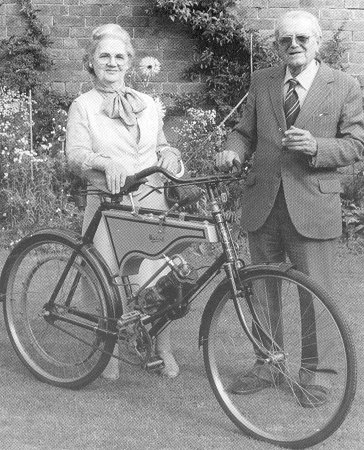
Mr. and Mrs. Albert Clarke with a 1901 Wearwell-Stevens
motorcycle. Photo courtesy of the late Geoff Stevens. |
The first machine appeared in the spring of 1901.
It was fitted with a 2½ hp. air cooled, 4-stroke Stevens engine, with automatic inlet valve, and
mechanically operated side exhaust valve.
The engine was mounted
above the front down tube. It had accumulator ignition, a surface
carburettor, a twisted
leather belt drive to the back wheel, and sold for 42
guineas.
The machine, which became very popular, was shown at the 1902
National Cycle Show at Crystal Palace. A number of improvements
were made, including a choice of surface or spray carburettor.
Orders poured in after demonstrations were given at the
show, and the price was
reduced to £40.
In 1903 further changes
were made. The rear wheel was now driven by a 'Lincona' vee
belt, and the surface carburettors were discontinued, in favour
of the spray type. |
| A close-up view of Albert
Clarke's motorcycle.
Courtesy of the late Geoff Stevens. |
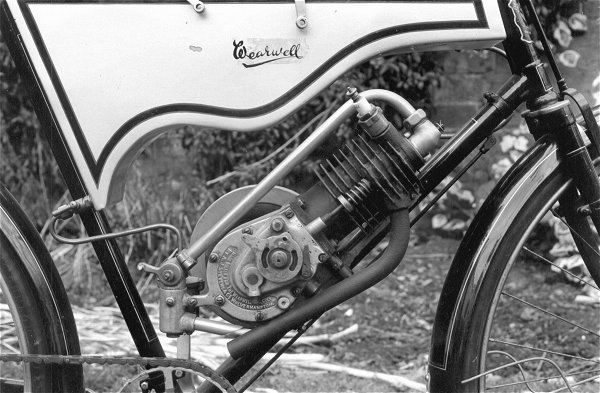 |
 |
Another Wearwell -Stevens
machine, as found in 1953.
Courtesy of the late Jim
Boulton. |
| 1903 saw the introduction of the
'Motette' powered tricycle, a modified version of the 2½
hp. bicycle. The front wheel was replaced
with a two wheeled axle, onto which an upholstered wicker seat
was attached. The machine sold for 53 guineas, and a conversion
for two wheeled machines was available for £16.5s.0d.
A 3¼ hp. version was also
available for £75.
Unfortunately the products proved to be unpopular. |
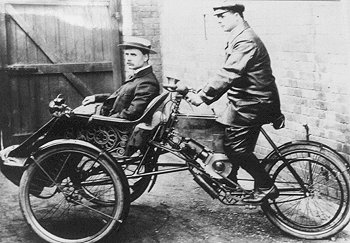
A 'Motette' with Harry Stevens as passenger, and Fred Adey
driver. Photo courtesy of the late Geoff Stevens. |

An advert from 1902.
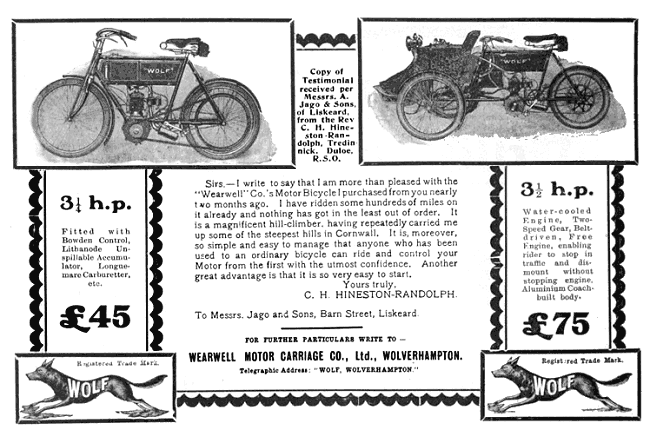
An advert from 1904.
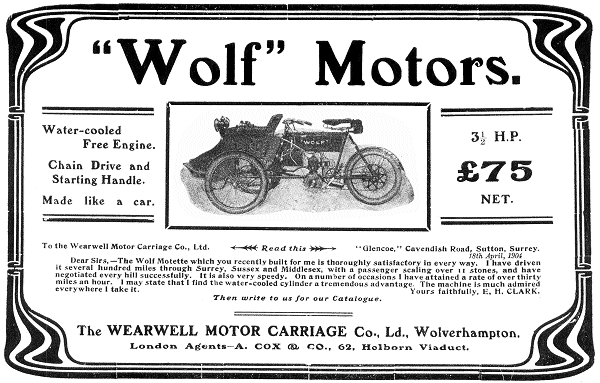
An advert from 1904.

Another advert from 1904.
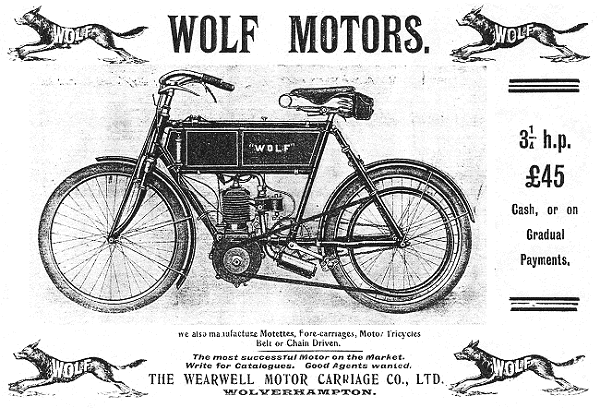
An advert from February 1904.
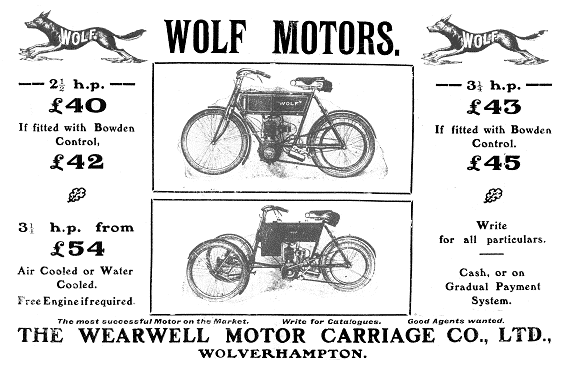 |
In 1905 a redesigned and sturdier model was
launched using the 'Wolf' name. It was fitted with a 3¼
hp. Stevens engine, which was vertically mounted
near the bottom bracket. By 1906 there were more than a dozen
models, and a wide range of engines to choose from.
Prices
ranged from 37 to 42 guineas. |
| Lightweight, heavy duty, and commercial versions of the
powered tricycles were also produced. The lightweight version was like
the original 'Motette' except that it included a 4½
hp., or 5 hp., water cooled, vertical twin engine. It had a
two-speed gearbox, a leather saddle, and sold for 75 guineas. The
heavy duty version, the Wolf Carette, was more like
a car. It had body panels, and was fitted with a
steering wheel. |
| It also had a 6 h.p. 2-cylinder, water-cooled,
Fafnir engine, a 2-speed gearbox and clutch. It had
an inclined pillar steering wheel, a lubricating
pump, and a shaft drive to a bevel gear on the rear
wheel axle.
There were two powerful brakes, a 6 gallon petrol
tank, and a weldless tube frame.
The car weighed 3½
cwt., and sold for 90 guineas. |

The Wolf Carette. |
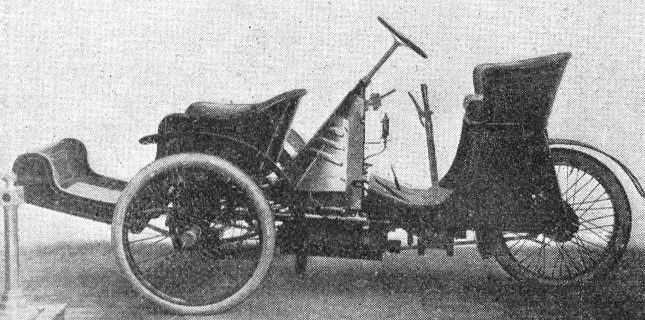
Another view of the Carette.
 |
The cheapest machine was the Wolf featherweight, which
was similar to the earlier powered bicycles and sold for 19 guineas.
Stevens also started to supply the company with frames, and the company
sold the Stevens 1½ hp. motor set, complete with all
parts for £14.
The Stevens brothers also started to ride Wolf machines
in reliability trials and speed events, with great success.
The 'Wolf Grand' was launched in 1909, and sold for £35.10s.0d.
Disaster struck in 1909 when it was discovered that the
Company Secretary, Mr. King, had been using the company's money to
gamble at pool in a local public house. A large sum of money had
disappeared, which led to the company going into liquidation.
Mr. King
tried to commit suicide, but William Clarke did not bring any criminal
charges against him, because he discovered that one of his brothers was
also involved. |
| By 1910 the Wolf machines looked more like a
conventional motorcycle. The machine in the advert
opposite has a direct belt drive, a magneto mounted
behind the cylinder, and a normal type of petrol
tank. |

An advert from 1910. |
|
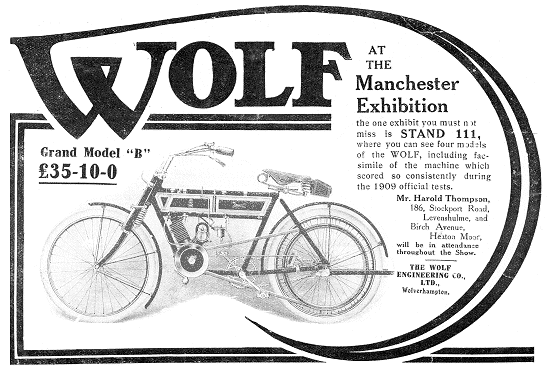
Another advert from 1910. |
After the liquidation, William still wanted to
continue producing Wearwell bicycles and so in 1911 he purchased
the ailing Wulfruna Cycles from John Barratt.
He attempted to
revitalise the business and reintroduced the Wearwell and Wolf
names at new premises in Brickkiln Street.
The production of cheap machines continued. A 2½ hp. 'Wolf'
was on sale in 1914 for just 22 guineas. |

An advert from 1913.
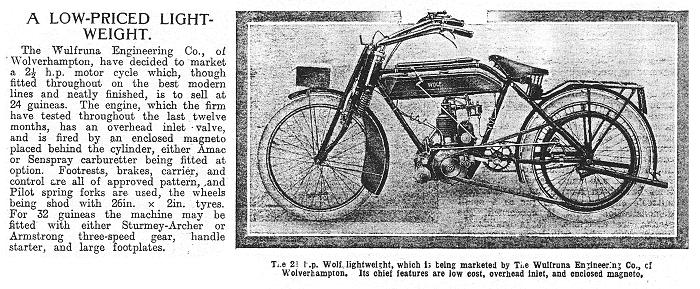
An advert from September 1913.
 |
The model 'F' lightweight
Wolf machine that's on display at the National Motorcycle
Museum, Birmingham.
It has a 147c.c. Villiers 2-stroke engine,
flywheel magneto, petrol lubrication, Amac carburettor and 2-speed gearbox. |
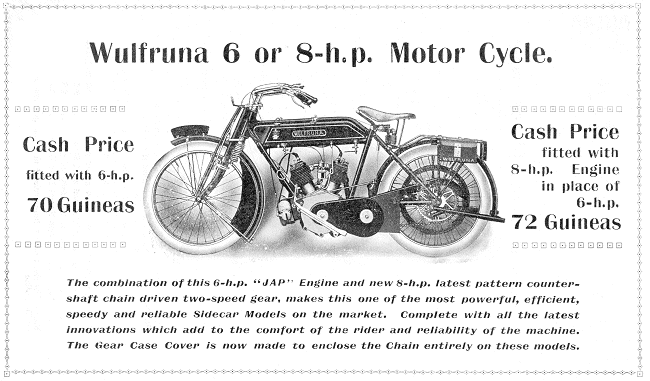
From the 1914 catalogue.
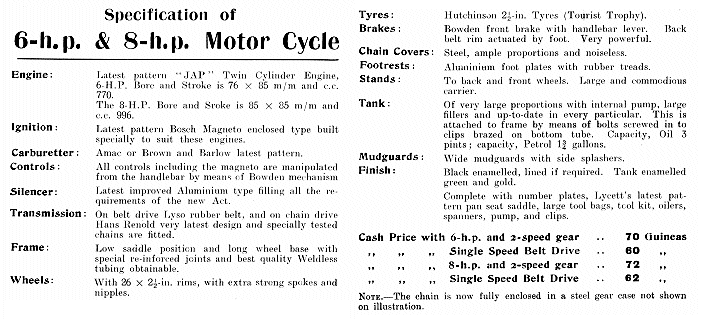

From the 1914 catalogue.
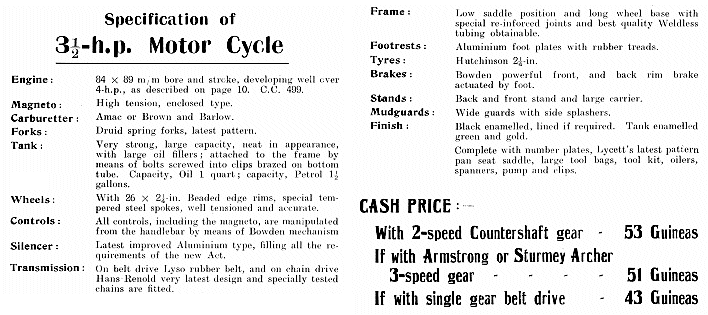
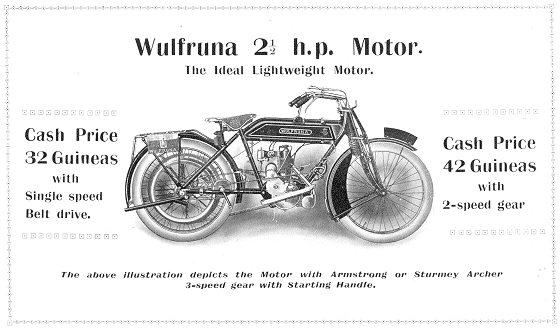
From the 1914 catalogue.
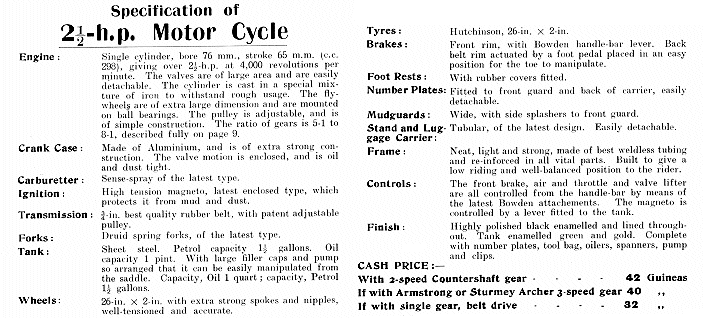
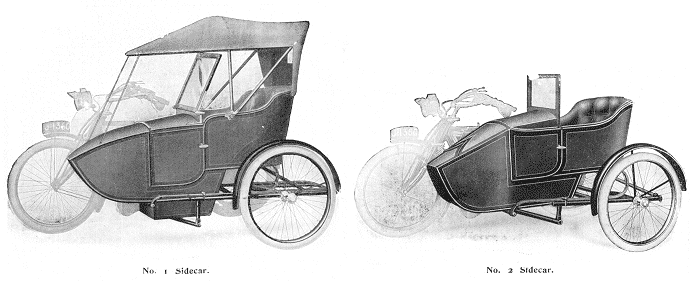
From the 1914 catalogue.
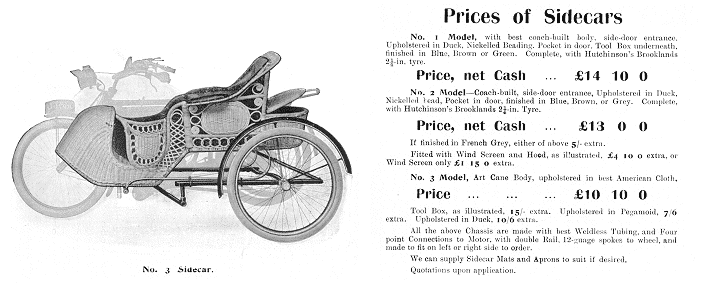
From the 1914 catalogue.
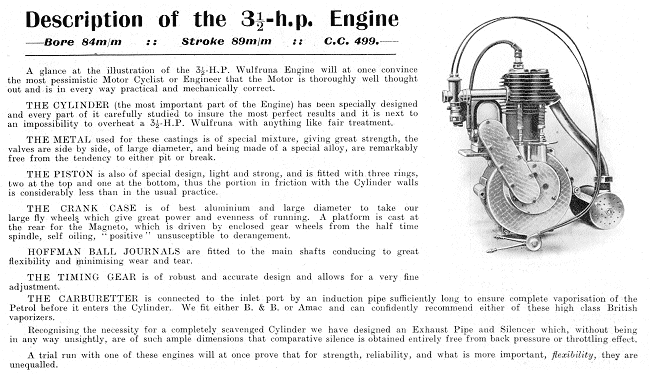
From the 1914 catalogue.
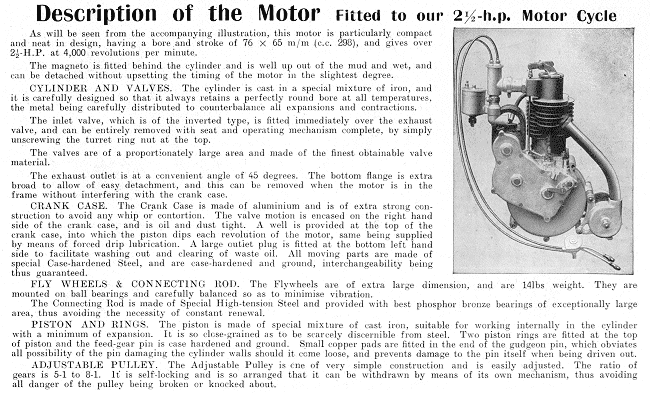
From the 1914 catalogue.
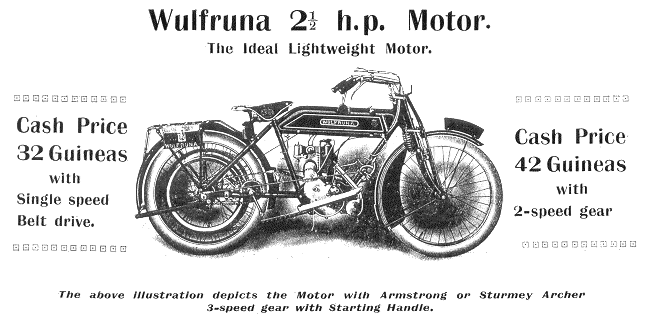
From the 1915 catalogue.
| A range of 'Wulfruna' machines was available
until the early 1920's, after which the company
concentrated on producing machines carrying the
'Wolf' name. William
Clarke died in 1922, and in 1928 Theo Waine and his
brother Mr. G. A.Waine, took over the Wearwell Cycle Company Limited from the
liquidators of the Wulfruna Engineering Company Limited. The Waine Family were
originally lock makers in Willenhall, and used to supply large numbers of locks to
the far east. They also used to make steel heel and toe tips for shoes, and
supplied them to the army in the first world war. They used to import
their steel from Belgium, and in those days it only cost £4 a ton. |
|

A modern view of New
Griffin Works. |
When Theo inspected the Brickkiln Street works, he
decided that it was not suitable for their purpose. Everything
was extremely old, and run down. The family
owned New Griffin Works in Colliery Road, Wolverhampton, and so the cycle
business was moved there. Part of the works was used for the
manufacture of bicycles and motorcycles, the remainder
being used for the family's other
business, Vulcan Manufacturing (Wolverhampton) Limited. Vulcan was a general engineering
company, producing all kinds of products, including locks, and items
in stainless steel, as early as 1934. |
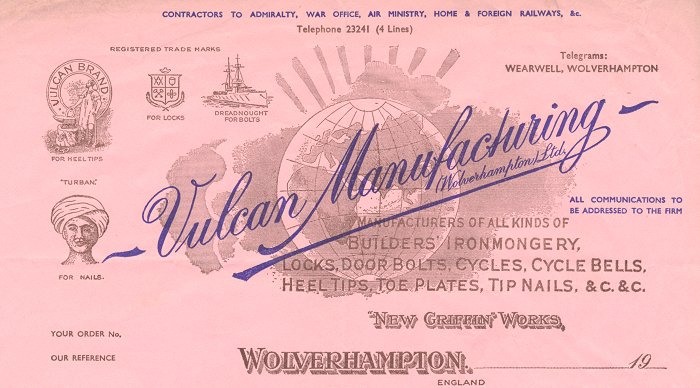
A letterhead from 1956.

An advert from 1930.
| In 1931 the factory was expanded, and a trade stand was taken at
Olympia. Mr. H. V.Waine, a keen motorcyclist was responsible
for the design and production of both motorcycles and cycles,
while Mr. T. A. Waine was responsible for sales.
The machines used Villiers engines. The 'Cub', which had a
98c.c. engine sold for only £15.15s.0d. The 'Wolf Silver Super
Sports' was powered by a 196c.c. Villiers engine, and sold for
only £34. |
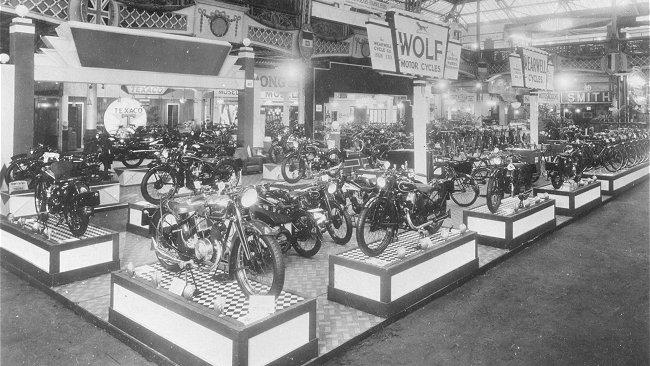
The Wolf stand at an exhibition in the
1930s. Courtesy of the late Jim Boulton.
| |
|
| View some of the
company's other products |

|
| |
|
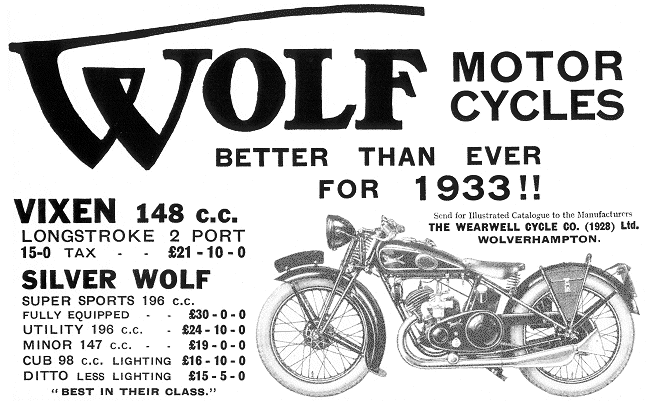
An advert from 1933.
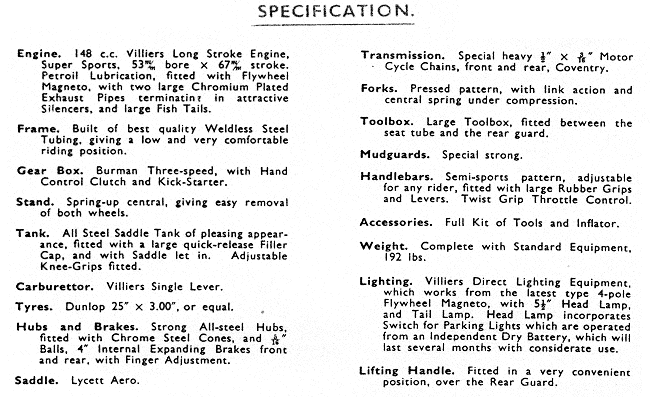
The specification for the Wolf Vixen.
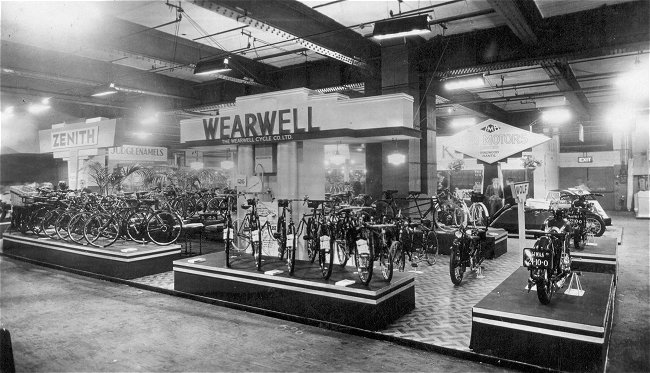
The company's stand at the 1934 Motor Cycle
Show.
|
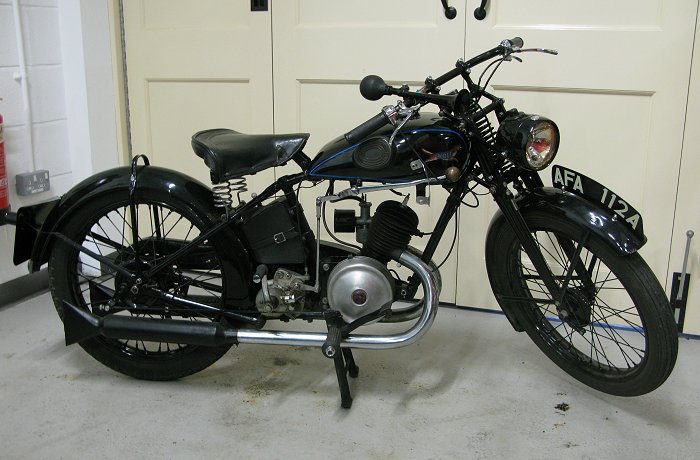
The Black Country Living Museum's
148 cc. Wolf 'Vixen' from 1936. |
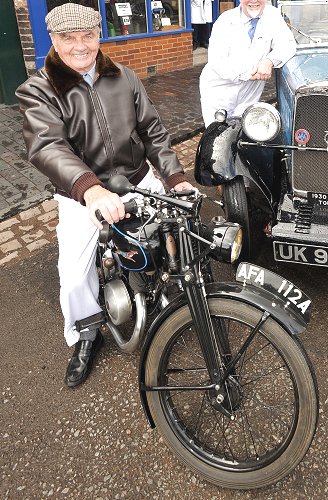 |
Wolf motorcycles
continued in production until the outbreak of World War
2. After the war the company decided to concentrate
solely on the manufacture of pedal cycles, and no
more motorcycles were produced.
The late Derek Spencer riding
his favourite motorcycle, the Wolf 'Vixen' at the Black
Country Living Museum. |

Nigel Martin's Wolf motorcycle at
the Penn History Fair in 2017. This is a late version of
the 'Unit' that was manufactured just before production
ended. |
|